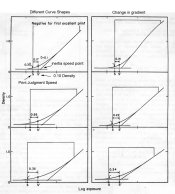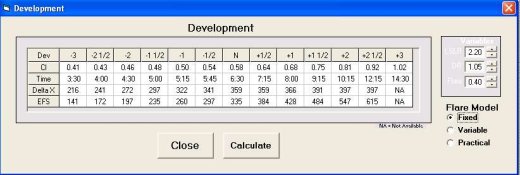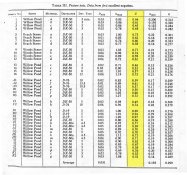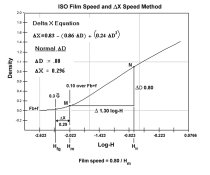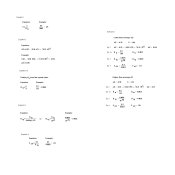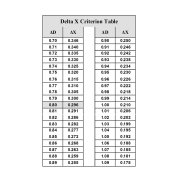You are asking the wrong question. ...
The chart shows three sensitometric exposures from the same film type developed to different contrast indexes. One corresponds to the ISO contrast parameters and the others are developed to a less and greater degree. An effective film speed was determined from each of the samples using both the 0.10 fixed density method and the Delta-X method.
View attachment 87261
... You don't need this stuff to shoot. I think it's good to know if only to understand the lack of precision with the type of equipment generally available and concern yourself with what's really necessary to produce good images.
Stephen,
First, thanks for taking the time to explain in terms I can deal with. I'm busy digging through the papers you posted. That said, the excursion is a bit on the superfluous side, since my primary concern/goal is to improve my technique in the field. And, although you maintain that, "you don't need that stuff to shoot," I'm finding that much of it is useful, if only in clearing the clutter of accumulated misconceptions and Zone System inaccuracies. I'll continue to use the Zone System, though, since I find it such a wonderful visualization tool, but I'll be trying to refine exposure some now.
I mentioned earlier a disconnect (for me, anyway) between ISO and personal E.I. This connects somewhat with your discussion on gradient speeds vs. fixed point speed. First, let me say that I'm now convinced that the Delta X or fractional gradient speed based on first excellent print testing is likely a better method than the Zone System fixed-point speed determination. But, if I accept that, then it would seem that much of the exposure compensation that I have been doing for expansions and contractions would be unnecessary. This confuses me a bit, for it really seems to me that when I make a negative of a very contrasty scene that requires, say, N-2 development, that, unless I give substantially more exposure (along the lines of that suggested by the fixed-point speed) to compensate for the reduced development, my shadow values suffer. Conversely, expansion negatives are often overexposed (which doesn't bother me much) if I don't compensate by reducing exposure.
This is the disconnect I am addressing. And, I don't even really know where to start asking informed questions about it except to fire away and hope you will indulge me yet again. So, did the first excellent print tests include lots of expansion and contraction subjects, or were they more or less concerned with prints of subjects with more "normal" SBRs? If so, then should we expect much different results for similar print tests with subjects with significantly higher or lower SBRs? If not, then why does it seem that in practice I have to compensate exposure for contractions and expansions than the Delta X or fractional gradient speeds would suggest?
I'll leave it at that for now, as I'm probably asking the wrong questions again

Looking forward to your answer,
Doremus








